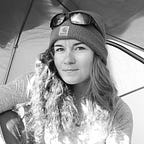Tagging Days
Tagging whales in Antarctica is harder than these marine scientists make it look.
“You have to pay attention to the behavioral state of the animals,” says Ari Friedlaender. “If they don’t want us there, we just have to move on.”
We’re all sitting in the common room aboard the R/V Laurence M. Gould — our eight-person team plus the six marine technicians — listening intently as Friedlaender shows videos and explains in detail exactly what goes into tagging Antarctic whales.
“Minkes are the priority but we’ll tag whatever species is there,” he says.
While Friedlaender has tagged hundreds of humpbacks over the years (as well as blue whales and other cetacean species) he has only ever placed suction-cup tags on three minkes. These special tags stay attached to the whales and collect data (including depth, speed, acceleration, location, and video footage) for 24 hours. When a tag falls off, it floats to the surface, and emits a GPS signal so the team can locate it and retrieve it.
With the expertise of the marine technicians at our disposal, we can use two small boats to deploy the tags — the sleek, race car red Solace, and the bulky black Zodiac. In addition to tags and the long poles used to deploy them, we’ll also take out echo-sounder and prey-mapping equipment, and several cameras.
Friedlaender told everyone to meet at on the bridge at 6am. By 5:59, we’re all here.
With an overcast sky above and glassy water below, we have perfect conditions for sighting whales. In fact we can already see two different groups of humpbacks in the distance.
The meeting is short — a quick review of the game plan, then we divide into teams and prepare to board the boats. We don multiple warm layers, bibs, gloves, waterproof boots, and Mustang survival jackets.
Dave Cade, Emma Levy, and I board the Zodiac. Cade talks with our marine tech, Julia Carleton, about the best tactics for approaching a whale. “We’ll come up on it slowly, and then when I say ‘go’, accelerate.”
It takes patience, intuition and a little bit of luck to securely place a tag on a large, wild animal moving through freezing water. Cade has been tagging whales for over four years, but even with all his experience, the process is still challenging. The first two whales we approach appear docile at first, but become a bit agitated after Cade attempts to place a tag.
Adhering to Friedlaender’s rule — if they don’t want you there, move on — we leave the pair of whales, and head back in the direction of the ship. Ten minutes later, we find a sleeping humpback. This time Cade places the tag with no issue.
After two hours, Friedlaender has placed three tags, and Cade has placed two. The first tagging team switches out with the drone team.
Dave Johnston holds a large hexacopter drone above his head as KC Bierlich mans the controls. Their precision and teamwork is flawless — in a matter of minutes, the drone soars over the whales, capturing beautiful aerial images that can also provide data about the animals’ body composition.
By lunch time, the team has tagged five whales, collected eight biopsies, completed five drone flights, and run the echo-sounder (fish finder) over 10 nautical miles.
“Humpbacks are a good confidence booster,” Friedlaneder says as he cleans the tagging equipment in the lab. While it has already been a very productive morning, the day will be deemed a true success if we can find and tag a minke whale.
So it goes in Antarctica. The showy, social humpbacks appear everywhere, while the elusive minkes shy away from the spotlight.
In the afternoon, Emma Levy and I stand on the bridge, acting as eyes in the sky to help the teams in the small boats find whales. Using binoculars, we scan across the bay. The Solace is on the far west side, while the Zodiac is half a mile away, currently floating just out of sight behind an ice berg.
Over the radio, we hear the Zodiac team trying to contact the Solace. “Solace, Solace — this is Zodiac. We have a minke over here.”
We don’t hear a response from the Solace. But when Levy and I look out over the starboard side of the ship, we spot a red dot on the horizon. Levy peers through the binoculars. “They are flying!”
We wait in silence, crossing our fingers, and picturing the sheer determination that must be on Friedlaender’s face right now. Ten minutes pass, then the radio crackles to life again. “Bridge, this is Solace. We have tagged the minke.”
Levy and I shout “yes!” at the same time. The first mate, George Longshore, smiles into the radio. “Roger that Solace,” he says. “Good work.”
Want to see more from the minke team in Antarctica? Check out our photos on Instagram and follow #insearchofminkes
